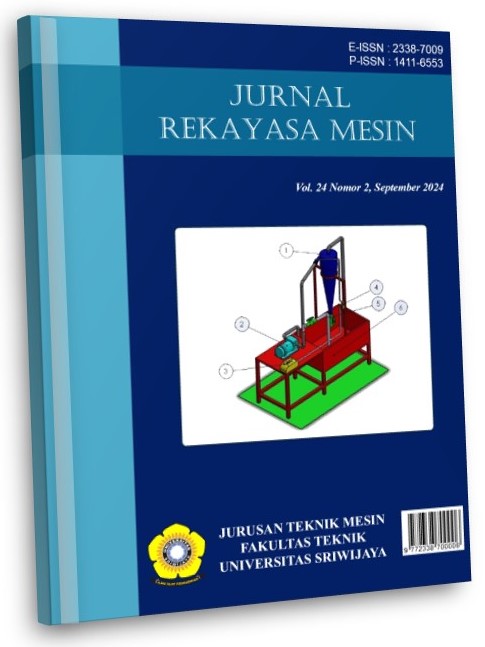Analisa Impak pada Desain Karakuri Kaizen Trolley dan Rak Statik Dua Tingkat dengan Metode FEA
DOI:
https://doi.org/10.36706/jrm.v24i2.1305Keywords:
Karakuri kaizen, Lean Manufacturing, FEA, SimulationAbstract
Karakuri kaizen is an approach to improve the efficiency of the production process by utilizing simple mechanisms that rely on the principles of mechanics without external energy (such as electricity or pneumatics). In this study, the impact analysis on the critical part of the karakuri kaizen design uses analytical and simulation methods. Simulation methods are divided into motion study, stress, strain, displacement, and velocity analysis. Impact simulation on dynamic rack mechanical stopper and impact simulation on static rack stopper. The results of analytical calculations and simulations on the box speed show that there are similarities in the time value and final speed of the box before stopping. The results of the impact simulation show that in the mechanical stopper path (a) the bolt pretension factor is still in a neutralized condition so that its effect is more dominant than the load on the box, the max stress ranges from 550-560 MPa and the strain is at 0.0025-0.0029. While the stopper path (b) oscillates with a max stress ranging from 270-320 MPa and a strain is at 0.002-0.0026. The box speed after impact is much greater than the input speed, due to the absence of a damping system, and the mass multiplier on the stopper being too large.
Downloads
References
S.D. Nascimento, M.B. Alves, J.O. Morais, L.C. Carvalho, R.F. Lima, R.R. Alves, R.D. Calado. “Karakuri: The application of lean thinking in low-cost automation”, Lean Manufacturing: Implementation, Opportunities and Challenges, p. 335-354, 2019.
H. Katayama, K. Sawa, R. Hwang, N. Ishiwatari, N. Hayashi. “Analysis and classification of Karakuri technologies for reinforcement of their visibility, improvement and transferability: An attempt for enhancing lean management”, PICMET 2014 - Portland International Center for Management of Engineering and Technology, Proceedings: Infrastructure and Service Integration, p. 1895-1906, 2014.
P. Nopitasari, R.A. Anugraha, W. Juliani. “Implementasi kaizen pada proses produksi galon air mineral untuk meminimasi waste waiting menggunakan metode lean manufacturing”, e-Proceeding of Engineering, Vol. 5, No. 3, 6644 – 6652, 2018.
I.M. Madisa, M.F.M. Taib, N.A. Reza. “Implementation of Karakuri Kaizen to improve productivity and ergonomics in wire rope industry”, Proceedings of the International Conference on Industrial Engineering and Operations Management, Vol. 2019, No. MAR, 2019. [5] D. Rani, A.K. Saravanan, M.R. Agrewale, B. Ashok. “Implementation of Karakuri kaizen in material handling unit”, SAE Technical Papers, 14th Symposium on International
Automotive Technology, SIAT 2015.
I. Masin, T. Riegr. “Dynamic characteristics of the karakuri transport trolley”, Proceedings of 6th International Conference on Trends in Agricultural Engineering 2016, Vol. 2016, p. 398-403, 2016.
D. Anggrahini, Y. Prasetyawan, S.I. Diartiwi. “Increasing production efficiency using karakuri principle (a case study in small and medium enterprise)”, IOP Conference Series: Materials Science and Engineering, Vol. 852, No. 1, 012117, 2020.
S. Harmanto, B. Tjahjono, I. Abbiyu. “Pengaruh sudut kemiringan shutter rack karakuri terhadap waktu penurunan polly box”, Prosiding 3rd National Conference of Industry, Engineering and Technology (NCIET), Vol. 3, 2022.
D. Dewi dan A.E. Pramono. “Rancang Bangun Karakuri Mixing dan Material Handling pada Proses Pembuatan Cetakan Inti Water Jacket”, Prosiding Seminar Nasional Teknik Mesin Politeknik Negeri Jakarta, 751–760, 2019.
A-.Y. Chang, P-.Y. Lai. “Promoting the Application of Refined Lean Automation - Take the Automobile Oil Seal Manufacturing Industry as an Example”, 2023 IEEE 5th Eurasia Conference on IOT, Communication and Engineering, ECICE 2023, p. 948-951, 2023
Y. Prasetyawan, A.A. Agustin, D. Anggrahini. “Simple automation for pinneaple processing combining with karakuri design”, IOP Conference Series: Materials Science and Engineering, Vol. 852, No. 1, 2020.
R.A. Febrianto, E. Liquiddanu, R.D. Astuti. “Design of Work Aids on Temporary Storage Stations Based on Karakuri Kaizen Principles (Case Study: Industri Tahu Sari Murni)”, AIP Conference Proceedings, Vol. 2674, 030034, 2023.
F. Bertagnolli, K. Herrmann, I. Rittmann, T. Viere. “The application of lean methods in corporate sustainability—a systematic literature review”, Sustainability (Switzerland), Vol. 13, No. 22, 12786, 2021.
M. Kostrzewski, W.J. Nowak. “Karakuri Solutions and Industry 4.0”, Handbook of Smart Materials, Technologies, and Devices: Applications of Industry 4.0: Volume 1-3, Vol. 1, p. 69-97, 2022
A.S. Baskoro, M.A. Amat, M.F. Arifardi. “Investigation Effect of ECR’s Thickness and Initial Value of Resistance Spot Welding Simulation using 2-Dimensional Thermo-Electric Coupled”, Transdisciplinary Research and Education Center for Green Technologies, Vol. 8(4), p. 821-828, 2021
M.F. Arifardi, A.S. Baskoro, M.A. Amat. “Development of 2-dimensional finite element modeling of resistance spot welding: 1st generation model electric-thermal coupled”, AIP Conference Proceedings, Vol. 2062(1), 020037, 2019
J. Fu, H. Haeri, V. Sarfarazi. “Extended finite element method simulation and experimental test on failure behavior of defects under uniaxial compression”, Mechanics of Advanced Materials and Structures, Vol. 29(27), p. 6966-6981, 2022
W.K. Liu, S. Li, H.S. Park. “Eighty Years of the Finite Element Method: Birth, Evolution, and Future”, Archives of Computational Methods in Engineering. Vol. 29, p. 4431-4453, 2022
Downloads
Published
How to Cite
Issue
Section
License
Copyright (c) 2024 Jurnal Rekayasa Mesin

This work is licensed under a Creative Commons Attribution-ShareAlike 4.0 International License.
Jurnal Rekayasa Mesin (JRM) memberikan akses terbuka terhadap siapapun agar informasi dan temuan pada artikel tersebut bermanfaat bagi semua orang. Semua konten artikel Jurnal ini dapat diakses dan diunduh secara gratis, tanpa dipungut biaya, sesuai dengan lisensi creative commons yang digunakan.





















